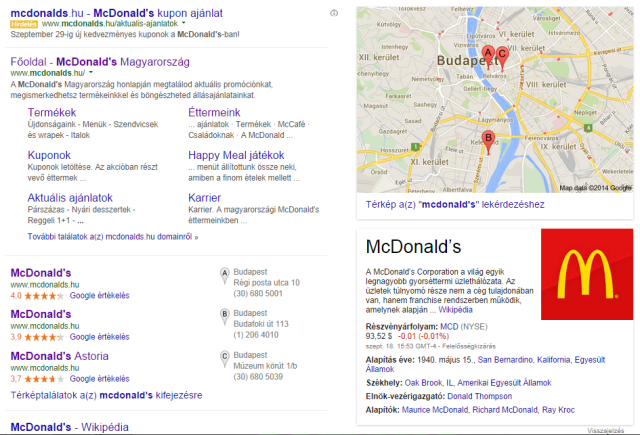Brand analysis | Weboptim
The English 'brand' means a brand or brand name. It includes the logo, the main slogan of our company and everything that people associate with the product/service. It positions the brand in the marketplace, among other competitors. Building a brand is long and time-consuming, you need to develop the right communication with consumers. Brand building can be said to have been successful if people can easily identify you by your brand name alone (without any other means of presentation).
Over the years, brand has become an important part of search engine optimisation. Search algorithms observe several aspects when determining the presence and relevance of a brand online. Examples include brand mentions on other websites, brand presence in the text of links to the site, search volumes and social network activity.
How do we manage our brand? This is a question every business owner faces, as it is a dilemma that can have a significant impact on brand perception. There are 4 main parts:
I. Reputation management
In the case of reputation, both the online and offline lines are relevant. When managing reputation, the key is to focus on social media platforms, but not to ignore traditional methods. The channels at our disposal:
- social
- phone
- e-mail, letter
- website
- in person
- forum, blog
We can try to ignore the negative feedback, but it's not worth it. You have to react. If we don't, we give others the opportunity to react (negatively) further. We also need to pay attention to positive comments, we don't know when we will need someone to help us spread a new product or message.
II. Fire protection
There are many unprotected brands, and this can pose numerous risks. Brand protection There are 3 main parts:
- trademarking: the brand name must be protected. It's time-consuming and complicated, so it's best to leave it to a professional.
- social properties: Today there are more than 500 social platforms, most of them relatively unknown, but you never know, one could be the Facebook of the future.
- domain: it's not enough to have a domain name - it's also good to think about typos - make sure people can find us even if they make a mistake when typing.
III. Page 1 domination
Users expect to get verified pages in brand searches, at least on the first page of Google.

Think of it as a link building project: you need to strengthen your different profiles so that Google knows that they are relevant to your brand. Such elements could be - in addition to the website itself - sitelinks, personal blogs, social profiles, PR articles, Google maps, etc..
IV. Fire monitoring
Brand monitoring is a strategy that allows you to monitor all sources that contain a particular company name, product or service.
Details of brand monitoring
The main elements are usually:
Positive comments
When we think of a brand, the first thing that comes to mind is what negative opinions are associated with it. It is true that these are important to identify, but positive comments can be almost as important.
Negative comments
No company wants to be discredited on the internet. By checking these posts often, you can find the negative voice and fix the problem before it causes more problems.
Competitors
Competitor monitoring is an important part of brand monitoring. It can help us find new ways to strengthen our own brand, as well as identify where our competitors are performing effectively.
Trademark infringement
Monitoring may reveal trademark infringement. Companies often go to great lengths to protect their trademarks, so it can be a pain point to see that someone else has stolen it.
Fake sites/products
For companies selling higher value products, the problem can often arise that some of the products they offer for sale are counterfeit. Big brands can suffer such inconveniences relatively often.
Content managers
If we know what content is popular on the internet, we can create similar content. If we find that a particular topic is very popular, we should write a piece of content that is relevant to that topic.
The importance of brand monitoring
The internet is evolving at a breakneck pace, we can't afford to be out of touch. As the number of websites grows, people have more and more opportunities to share their opinions about a company/product. These views must be monitored to avoid any negative consequences.

What to monitor?
It is important to find the keywords that users use when they mention our brand. If the brand name includes a more general term, it can lead to a lot of irrelevant mentions of us, and this is something to avoid. The main parts of monitoring are:
- brand name
- brand name variations (typos, abbreviations)
- trademark and copyright
- names of senior managers
- key products (only if specific)
- competitors
Which websites are we looking at?
A multitude of websites, that's the internet. People can talk about our brand or service in countless places, so we need a strategy that monitors them all.
Brand mentions are often found in the following places:
- social media sites (restrictions may apply)
- personal and corporate blogs
- forums
- news sites
- video sharing
- image sharers
- competitors' website
- consumer websites
Depending on the size of your niche, you may get more mentions on some sites and fewer on others.
Handling negative mentions
If a negative opinion is found, it is crucial that it is dealt with as quickly as possible. A good solution may be to contact the person who made the criticism, either through the site or by other means (such as an email message). Move the conversation from the online space to the offline world.
If a negative comment is left, it may be worth responding to the comment by apologising for the problem, so that we can let customers know that we care about their opinion and satisfaction.
Trolls
Trolls are basically users who, hiding behind anonymity, formulate criticisms laced with negative emotions.
It is important to know that a troll is not someone:
– who disagrees with us: some topics can simply trigger strong emotional reactions in people. In the debate, everyone shares their opinions and experiences. If someone disagrees with us or asks a question in a respectful way, they are not considered a troll.
– does not want to read the post: not everyone is part of the target audience, that's natural. Just because you don't like someone's comments doesn't mean you can call them a troll.

What can we include here?
- angry responses that put the brand in the spotlight
- excessive criticism of spelling
- excessive use of capital letters and dramatic statements
- racist, homophobic and derogatory remarks
Exploiting positive reviews
Many brands are looking at the group of people who are constantly trying to promote the brand in a positive way: sharing content. We can reward them with various discounts.
Internal brand monitoring
In addition to external communication, it's also worth paying attention to internal communication: to the people who work for us. In particular, if they have indicated that they work for us or are notable people within the company. It is also important that whoever manages the company's social media accounts is properly trained.
Brand monitoring is therefore of paramount importance. If we don't know what people are saying about us, we may be in for a nasty surprise a few months later.
With our service you can map your brand's entire online presence.